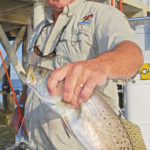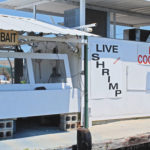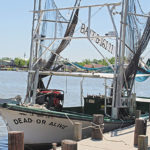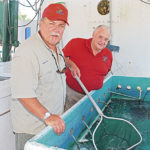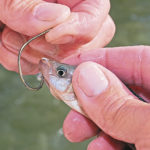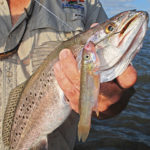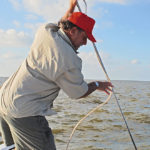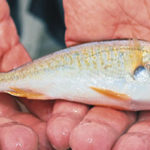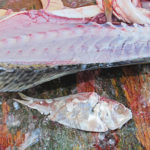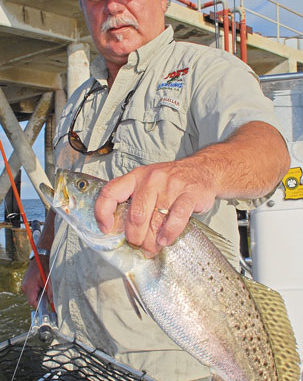
Live bait delivers Barataria Bay speckled trout strikes
Except for the glittering lights of Lafitte on one side of the bayou and Barataria on the other, the night was pitch-black. It was a beautiful sight on Bayou Barataria.
Then as the boat neared one of Lafitte’s shrimp-buying docks, it hit a wall of “olfactory stimulation.” There is nothing like the redolent smell of shrimp juice that has been fermented in Louisiana’s near tropical temperatures.
“Hoo-whee,” exclaimed Deano Bonano loudly. His partner, Sid Bourgeois, was silent. But by the boat’s running lights, a distinct grin was visible under his drooping mustache. As a resident of the small community south of New Orleans, he knew the smell. It was the smell of money for the villages’ shrimpers.
The two dedicated live-bait users were on an excursion into Barataria Bay to work over the bay’s trout. Fishing, when weather permitted, had been exceptionally good since it re-opened after the BP oil spill.
Bourgeois keeps tabs on fishing closely from Joe’s Landing, the business that he and his father built 35 years ago. The full-service marina in Barataria stocks and sells what he loves to fish for trout with — live bait, specifically live shrimp and cocahoes.
Bourgeois hails from a legendary Marrero outdoors family. One third cousin, Theophile, is a high-profile fishing guide and lodge owner. Another, Alden Jr., is also a well-known guide and expert taxidermist. Alden Sr. was a dedicated
deer hunter.
“I love to fish,” said Bourgeois, “and my father [Joe] loves to fish.
“He loves to speck fish, but he loves bass fishing with a fly rod more than anything.”
Bourgeois was quick to add that his two grown daughters, Jessica Coulon of Barataria and Jamie Victoriano of Lafitte, are also active anglers.
His late uncle Sidney, a serious rabbit hunter known to everyone in Barataria and Marrero as “Shorty,” always identified the family as “boogalee,” a word The Dialect Dictionary defines as meaning “Cajun.” Bourgeois grinned knowingly and chuckled at mention of the name.
“What Uncle Shorty meant was that we are half-Cajun and half-Italian,” he said.
Bonano, pure Italian, lives in Metairie, but spends as much time as possible scouring Barataria Bay for speckled trout and redfish. The tall, athletic bundle of energy instigated this trip with his friend of 25 years.
Bourgeois guided the boat south from Lafitte-Barataria. First stop was what he identified as Perrin’s Point in Redfish Bayou. All that marked the spot were two old pilings from what apparently was an old shrimp-drying platform. Bourgeois impaled a shrimp on his hook, and Bonano pushed a kahle hook through the jaws of a cocaho.
The men fanned casts in all directions. The only specks they caught were 9- or 10-inch peewees, and not many of them. In 20 minutes, they picked up anchor and ran farther south to Bassa Bassa Bay to a loose grouping of cockeyed pilings, the remains of an old camp.
While they soaked their live baits, I asked Bourgeois why he thought that live bait is effective.
“It’s a natural bait,” he began. “Give ’em what they want. And most of the time a person will catch larger fish on live bait. It’s like fishing perch with a box of worms — you’re gonna catch something. Just call home and tell your wife to get the grease hot.”
So I naturally asked why anyone uses artificial lures if live bait is so much better.
“Well, to begin with,” he replied, “it’s slow. It takes patience. Cost is another reason. Aritificials can be cheaper. The average boat that we launch takes about $35 worth of live bait. And you don’t have the hassle of dealing with live bait. You have to dip them, handle them and hook them. With artificials you just throw back out right away.”
One thing that he notes is that summer months are best for live-bait fishing. He feels that fish are less active in the winter and that artificials can do as well as live bait.
Like at the first stop, the water was dingy, not muddy, not milking — just plain dumpy looking. It didn’t look like good fishing water. The spot also produced only peewees and even less of them than the first spot.
Before leaving, the two men consulted in the early morning’s light. Bourgeois followed Bonano’s advice — go south young man, go south.
Third stop was a long complex of connected platforms set on wooden pilings in West Champagne Bay. The water was crummy here too. The pair didn’t get a bite. But Bourgeois didn’t lose confidence.
“The tide is good and the fish are here somewhere,” he said. “We just have to find them.”
He headed farther south and then east, making a great circle through Barataria Bay nearer the gulf. The story was the same, murky water everywhere. Until the day before the trip, the wind had blown with ferocity for nearly a week, and the water hadn’t had time to clear.
Next stop was a derelict-looking, closely-spaced cluster of three platforms. Two of them were on concrete slabs and had concrete pilings. The third platform, set on wooden pilings, held two large tanks. Anchor-eating debris, both from the destruction wrought upon the platforms by Hurricane Katrina as well as from years of work, littered the water bottom around the platform, explained Bourgeois.
Here, instead of a Danforth anchor, Bourgeois opted to use his Cajun Anchor. The deep water made the task difficult, and when he hurled it into the water, he looked for all the world like Moby Dick’s Queequeg, the chief harpooner of the Pequod, targeting a sperm whale.
I asked for the name of the platform. Bourgeois shrugged and said “Shrug Rig.” He caught my quizzical look and added, “That’s a name Bob Marshall (the outdoors writer for The Times-Picayune) gave it. Every time I stopped here he would ask me the name and I would just shrug.”
Bonano was slightly more helpful.
“I have always called it the concrete platforms,” he said.
Bourgeois described it is an abandoned platform about 2 miles south-southeast of the Saturday Island platform, a well-known Barataria Bay landmark.
The water here was no better than anywhere they had been. A hand thrust into it disappeared before the water got to the elbow. But they immediately began getting bites on both shrimp and cocahoes. Many of the bites were gentle nibbles and nudges, but enough of them paid off for them to begin putting 1- to 2-pound specks in the boat.
Their terminal rigs were very similar. Both men used 2/0 kahle hooks. The main reason is that kahles snag less frequently on the bottom than do treble hooks. Bonano noted that it is also a lot easier to unhook fish with kahle hooks than treble hooks.
“I even use larger sizes offshore,” he added.
Both also used Carolina rigs, an 18-inch 30-pound-test monofilament leader with the hook on one end and a small swivel on the other. Above the swivel, they threaded a ¼-ounce egg sinker on their 12-pound-test line. Bourgeois noted that he, on occasion, uses sinkers as large as ½-ounce, but he prefers the smaller ones because they don’t dig into oyster shells as much.
Bourgeois prefers to fish over bottom debris and oyster reefs, which takes a heavy toll on his leaders. He keeps extra pre-rigged leaders on a Jero’s Tackle Snelled Hook Holder. The green plastic tubes, which he sells with or without rigged leaders at his marina, hold 16 ready-to-go leaders. When the trout bite is on, time is fish.
He seldom fishes live bait under a cork.
“I like to tight-line,” he said. “I like to feel the bite versus watching the cork go down. And, for some reason, I usually catch bigger fish on the bottom than under a cork.”
“Look at this,” Bourgeois muttered at one point while his rod tip twitched steadily as fish bopped his bait. “That trout is trying to kill the cocaho.”
But as the men fish, the bite increased in intensity, rather than decreased. They had fewer taps and more vigorous hits. Specks steadily came over the rail, and they increased in size, as well, some of them pushing 3 pounds, really good fish for Barataria Bay.
Bourgeois glanced at the murky water and looked up.
“That’s why we’re fishing with live bait,” he said. “Try doing that in this water with artificials.”
As experienced as Bonano is, even he was impressed.
“I don’t know if I have ever caught this many fish in water this bad,” he said.
As the bite reached its peak, every cast triggered an almost instant strike. Many of the trout seemed to throw the hook right at the boat. At one point, Bonano jokingly scolded Bourgeois after he lost three nice trout in a row at the boat.
“What are you doing? Playing catch and release! I eat this stuff, you know.”
Bourgeois’ reply was a pained grin.
If an ice chest could groan, the 96-quart one in the front of the boat would have. When Bourgeois added a layer of ice, the box was nearly full, in spite of being a few fish short of a limit. They decided to quit early. It still wasn’t noon, but the box cried “enough, already.”
On the ride in, I pressed Bourgeois about whether using live bait is the answer to making an also-ran angler into a master. He seemed reluctant to reply.
“Live bait will make anyone better, but you still need to find fish,” he said. “You need to locate the better spots.
“Know your tides, know the points where current moves around. Those are important.”
